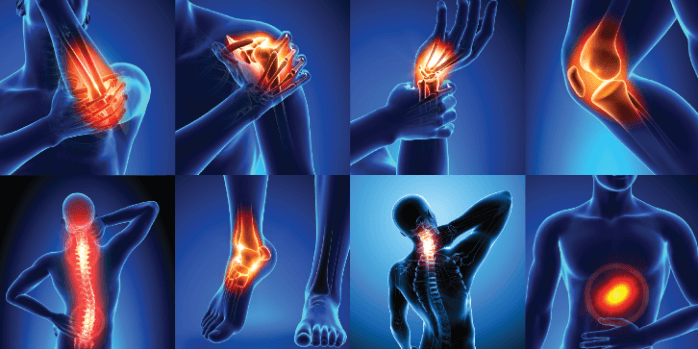
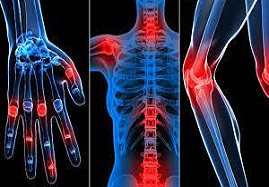
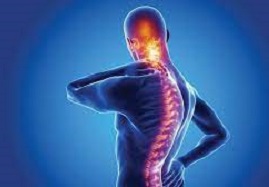
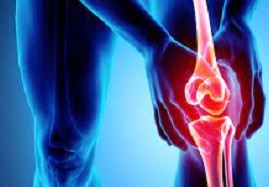
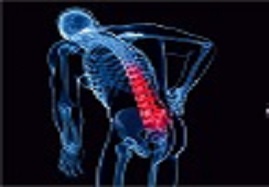

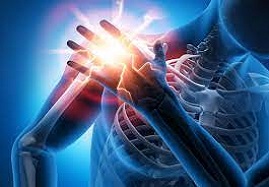
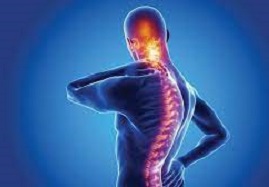
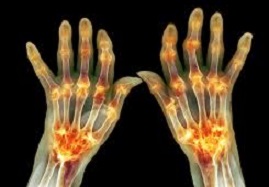


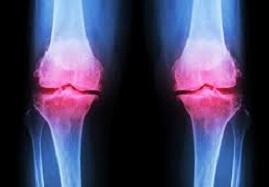
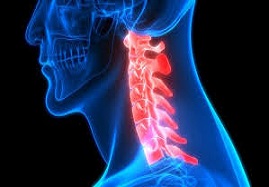
A joint is a point where bones make contact, connecting the skeletal system. Most joints are mobile, which allows the body to make different types of movement. There are three kinds of joint: fibrous, cartilaginous, and synovial.
Fibrous joints are usually immovable. They include the cranium in the skull, the joints between the teeth and the sockets in the jaw, and the joints between the bones of the lower leg.
Cartilaginous joints are those where cartilage joins two bones. These joints are partially movable. One example is the joint between the right and left pubic bone.
Synovial joints are the joints that allow limbs to move freely. These joints have a cavity in them that contains synovial fluid. This fluid allows the bones that connect the joint to move around with ease. Some examples include the knee, elbow, hip, and shoulder.
.
Joints are the parts of your body where your bones meet. Joints allow the bones of your skeleton to move. Joints include:
Joint pain refers to discomfort, aches, and soreness in any of the body’s joints. Joint pain is a common complaint. It doesn’t typically require a hospital visit. Sometimes, joint pain is the result of an illness or injury. Arthritis is also a common cause of joint pain. However, it can also be due to other conditions or factors.
.
Many conditions and factors can cause a person to experience joint pain. If a person has pain in multiple joints, it is known as polyarthralgia. Usually, joint pain is the result of injury, infection, illness, or inflammation.
Below are some of the common causes of joint pain:
Injury is a common cause of joint pain. Injuries can result from the excessive use or effort of the joints or from an impact that causes a fracture, sprain, or strain.
For example, a common knee injury is damage to the anterior cruciate ligament (ACL). People who play certain sports, such as soccer, basketball, or football, are more at risk of injuring their ACL.
.
Some infections may result in joint pain. For example, the hepatitis C virus (HCV) can cause complications that result in joint pain. It is common for people with HCV to have related rheumatic diseases, which can cause problems, including joint pain.
.
Some diseases can cause joint pain. Lupus is a chronic autoimmune disease, and common symptoms include muscle and joint pain. In fact, joint pain is the first symptom for more than half of those who develop lupus.
People develop lupus because their body’s immune system becomes hyperactive and attacks normal, healthy tissue.
.
One of the most common causes of joint pain is arthritis. The two main forms of arthritis are osteoarthritis (OA) and rheumatoid arthritis (RA).
OA is most common in adults over age 40. It progresses slowly and tends to affect commonly used joints like the:
Joint pain due to OA results from a breakdown of the cartilage that serves as a cushion and shock absorber for the joints.
The second form of arthritis is RA. It more commonly affects women than men.
It can deform and debilitate the joints over time. RA causes pain, inflammation, and fluid buildup in the joints as the body’s immune system attacks the membrane that lines the joints.
.
Joint pain can be caused by:
According to Ayurveda, joint pain occurs due to the imbalance in the functional energy or Dosha in the body, known as Vata. This energy is responsible for movement and spaces, which corresponds to the space between the joints. An imbalance in a form of Vata known as Vyanavata can cause circulation problems.
As a result, the tissues fail to get nourishment. This leads to wear and tear causing severe joint pain. One more form of energy is the Shleshaka Kapha. This helps keep the joints lubricated allowing for smooth movement.
Imbalance in the Doshas causes the weakening of the digestive fire. This causes the accumulation of toxins. The toxins are carried to the joints by Vata and they also cause joint pain. The Shleshaka Kapha gets dried up due to the presence of toxins. This affects the lubrication in the joints causing joint pain.
Ayurveda believes that to help manage joint pain, helping to maintain the Dosha is necessary. This can be done through the help of therapies, helping to make dietary and lifestyle changes, and using Ayurvedic herbal supplements.
.
In some cases, your joint pain will require you to see a doctor. You should make an appointment if you don’t know the cause of your joint pain and are experiencing other unexplained symptoms.
You should also see a doctor if:
Go to the emergency room if any of the following occurs:
.
Our doctor will probably perform an exam on the call. They’ll also ask you a series of questions about your joint pain. This may help to narrow down the potential causes.
A joint X-ray may be necessary to identify arthritis-related joint damage to access the gravity of the pain.
If your doctor suspects there’s another cause, they may order a blood test to screen for certain autoimmune disorders. They may also request a sedimentation rate test to measure the level of inflammation in the body or a complete blood count.
.
Joint pain is often a result of the damage that occurs through normal wear and tear. However, it can also be a sign of an infection or potentially debilitating RA.
You should see your doctor if you have any unexplained joint pain, especially if it doesn’t go away on its own after a few days. Early detection and diagnosis can allow for effective treatment of the underlying cause of your discomfort.
,
Joint Pain can have many different causes. For many people, joint pain is caused by arthritis, a group of conditions marked by inflammation in the joints.
Osteoarthritis has been affecting more than 15 million adults annually, with India contributing 22% to 39% share to the global numbers.Osteoarthritis can typically affect hands, hips, and knees. After this, the other common joint pain conditions affecting Indians are gout and rheumatoid arthritis.
In India, severe vitamin D deficiency, obesity and poor nutrition make women more susceptible to arthritis. As a result of this, the average age for the onset of knee problems is 50 years among Indian women while it is 60 years for men.
Even in general, women are twofold more prone to arthritis than men.
For others, joint pain may be caused by an injury or infection of the joints, or another condition, such as fibromyalgia or even depression. It can also be the result of poor posture or long periods of inactivity.
It’s possible for people with arthritis to help their symptoms, but many don’t know how. Treating joint pain isn’t always as simple as taking a pill or doing a few exercises, but ignoring the pain won’t make it go away.
Fortunately, there are many available treatment options that you can try. Depending on the cause and severity of your joint pain, you can find the combination of treatments that work for you.
.
Many causes of joint pain can be managed at home with a few lifestyle changes.
To reduce stiffness in the joints, try alternating cold with hot treatments. Warm showers or baths may help lessen stiffness in your joints in the morning. At night, you can try sleeping with an electric heated blanket or a heating pad.
Cold treatment is also helpful for relieving inflammation in the joints. Wrap a gel ice pack in a towel and apply it to painful joints for 20 minutes at a time, several times a day.
.
Eating a diet rich in whole grains, fruits, and vegetables might reduce the symptoms of arthritis.
Research suggests that a diet rich in omega-3 fatty acids and antioxidants can help prevent inflammation. These foods include:
On top of including more of these foods in your diet, be sure to also cut out processed carbohydrates and saturated or trans fats.
.
Physical activity, such as walking or swimming, can not only decrease pain, but also improve your mood and quality of life. The CDC suggests that people with arthritis should try to get at least 150 minutes of physical activity each week.
Make sure to avoid activities that are more likely to cause joint injuries, such as high-impact exercises like tennis or running.
Yoga is an excellent activity for people with joint pain.
If you’re overweight, you can reduce joint pain and arthritis symptoms by maintaining a healthy weight. Added weight puts more pressure on your joints, particularly your knees, hips, and feet.
If you’re having trouble losing weight, our doctor can to get you started on your weight loss journey.
.
Dietary supplements may help to relieve symptoms such as inflammation and joint pain. No dietary supplement has shown clear-cut benefits for joint pain, but there’s some evidence a few supplements might help.
Examples include:
Keep in mind that if your joint pain is being caused by another condition, such as RA, home remedies like supplements should never replace medical treatment.
.
The science of life, Ayurveda, holds all the secrets to various health concerns and cures for the human body.
The ancient knowledge of Ayurveda is based on the foundations of harmony and balance within the human body and between the body and its surrounding environment. According to Ayurveda, our body is a harmonious amalgamation of different parts that co-exist together, enabling us to participate in our day-to-day functioning.
Our joints are the connections between two bones that facilitate this movement in our body. However, there are several factors that can cause severe problems and damage to our joints, resulting in the commonly found concern of joint pain, which can have a direct impact on our motion.
.
There is a reason why the phrase ‘Prevention is better than cure’ is vital in healthcare. The all-encompassing knowledge of Ayurveda has been incorporating this vision since ancient times. Nidana Parivarjana (avoidance of causative factors) is an ayurvedic term viewed as the initial footmark for any disease. Therefore, incorporating preventive measures into our daily routine or dinacharya is a foolproof method of ensuring holistic health and wellbeing.
Ayurveda offers a wide range of solutions and lifestyle practices on how to prevent joint pain. Adopting healthy habits such as regular exercise, avoiding tobacco products, intaking a balanced diet, and maintaining a healthy body weight can help avoid joint pain and related concerns. Along with this, one should be careful while performing strenuous physical activities such as working out and lifting heavy objects.
They add further pressure on weight-bearing joints, which can result in injuries or straining. Other than these everyday activities, one should also incorporate ayurvedic herbal remedies and ingredients in their diets or separately for daily consumption in the form of tablets, capsules, herbal teas, or powders.
Finally, one should regularly perform abhyanga massages with ayurvedic oils to ensure joint flexibility, stability, and smooth movement of joints.
.
Whether chronic or mild, joint pain is a health concern faced by millions of people across the globe. It may start as a mild pain that gets easily sidelined and is ignored but can quickly turn into a chronic disorder. Therefore, we must take the proper care and measures to ensure our joints’ health and smooth functioning. Incorporating natural home remedies and practices in our daily lifestyles is one of the best ways to take care of our joints.
Ayurveda offers a plethora of natural remedies and herbal blends for joint pain and care.
Turmeric or Haldi is a bright yellow spice that is often used in Ayurvedic remedies. Curcumin in turmeric has anti-inflammatory, antioxidant, and anti-cancer properties that can significantly reduce joint pain. Turmeric is widely used in cooking in a lot of South Asian countries. Its anti-inflammatory properties are significantly helpful for people with rheumatoid arthritis, in which the body’s immune system starts attacking itself, leading to inflammation and pain in the joints.
It also improves joint flexibility and support thus is highly effective for knee pain too. Knee pain is one of the most common joint pains people suffer as it is a weight-bearing joint in our body. Turmeric can either be consumed as a spice in the form of turmeric powder or as a supplement in the form of capsules or joint care ayurvedic tablets.
.
Ginger, another commonly found and used spice, can significantly improve joint pain. A 2001 study by R D Altman and KC Marcussen shows that ginger extract had a statistically significant effect on reducing symptoms of Osteoarthritis of the knee. Like turmeric, ginger also has anti-inflammatory properties that can reduce joint pain and improve joint health simultaneously. Regular consumption of these spices can help reduce the humiliation of ama in the joints, thereby restoring the optimal levels of the Vata Dosha. Ginger is a popular and natural herbal remedy that can be consumed as a spice, natural extract, herbal tea or capsules. It is a widely available spice that tackles the inflammatory response initiated by joint pain and significantly reduces aches.
.
Ayurvedic oils have been used for centuries for their therapeutic properties. Abhyanga, oil massages on the entire body with warm oil calm the body and the mind while significantly reducing bodily pains.
.
Dashmula or ‘ten roots’ is a herbal mixture of ten tree and shrub roots such as Patala, Gambhaari, Brihati, Shalparni, Shyonaak, Gokharu, Kantkaari, Agnimanth, Bilva, and Prishniparni. This herbal remedy can combat symptoms of arthritis such as swelling and pain. It has an analgesic, antioxidant, and painkiller effect on arthritis symptoms such as swelling and joint pain. Its anti-inflammatory properties can combat inflammation in joints, which is a common ill-effect of rheumatoid arthritis. It also acts as an antioxidant, analgesic, and sedative to help improve digestion, nerve related health concerns and reduce muscle spasms. Dashamula can be used in the form of ayurvedic massage oil or can be consumed as a powder.
.
.